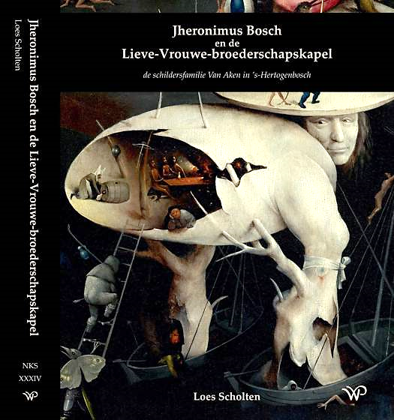
Scholten 2024a
JHERONIMUS BOSCH
EN DE LIEVE-VROUWE-BROEDERSCHAPSKAPEL
De schildersfamilie Van Aken in ’s-Hertogenbosch
(Loes Scholten) 2024
[Nijmeegse Kunsthistorische Studies – XXXIV, Walburgpers, Zutphen, 2024, 275 pages]
This is the commercial edition of the dissertation defended by Loes Scholten at the Radboud University Nijmegen on October 3, 2024. Its promotor was A.M. (Jos) Koldeweij). This dissertation focuses on a broad selection of sources from Bosch’s times and close environment which relate to the context in which his art was produced. The main focus does not lie on Bosch’s works nor on just those archival sources mentioning the artist but on all contemporary written sources that may inform us about Bosch’s living and working conditions, his identity, his network, and his status. In particular Bosch’s relations with the ’s-Hertogenbosch Brotherhood of Our Lady are the object of this context-directed study.
Scholten’s book has two major parts. The first part, limited to chapter 1, offers a survey of Bosch’s living and working environment based on archival sources. The reader learns how contemporary written sources inform us about Bosch’s name (Christian name, surname, alias), about his origin, about his workshops (his father’s workshop and his own), and about his neighbours, relatives, assistants and financial status.
The second part comprises four chapters. Chapter 2 introduces the ’s-Hertogenbosch Brotherhood of Our Lady. Chapter 3 focuses on the late gothic art that was present in the Brotherhood’s chapel (in St. John’s, back then still a church and not yet a cathedral), whereas chapter 4 zooms in on the altar and the altarpiece of this chapel. Here it is noteworthy that Scholten hardly pays any attention to Jos Koldeweij and Bernard Vermet’s 2001 hypothesis that Bosch’s Berlin St John on Patmos panel and Madrid St John the Baptist panel functioned as the upper exterior wings of the altarpiece. Scholten only writes (in translation): These identifications have been subject to debate and the surviving archival sources offer no information that can settle the dispute (p. 196). Chapter 5 takes a closer look at the professional contacts between Bosch and his family and the Brotherhood.
Noteworthy about this last chapter is that Scholten tries to identify two Bosch assistants: Jan Claessoon and Ghysbrecht Hoeyen. On the same page, though, we read words and phrases such as possible, assumption, probably, seem to be and it is not implausible, which asks for due caution. Interesting as well is appendix VI (pp. 224-227) which focuses on two well-known but hardly researched paintings in private collections (David and Abigail and Solomon and Batsheba) that may be copies of wings of the Brotherhood’s altarpiece. The colour photographs of these two paintings (see p. 225) are rare.
Scholten concludes that the sources not only endorse Bosch’s exceptionally creative and inventive qualities, but also characterise him as a highly skilled craftsman who took on not only the most prestigious projects, but also simple painting jobs and designs for applied art. Moreover, it is a fact that Bosch could count on the help of workshop assistants and apprentices.
Loes Scholten is the driving force behind the digital databank ‘BoschDoc’, which brings together (basically) all old written sources, in particular archival sources, that have a close or distant connection with Bosch, transcribing them, translating them into different languages, and commenting on them when necessary. This achievement is already impressive enough to account for Scholten’s Ph.D. title. Her dissertation, too, is a proof of sustained diligence and collects in a conveniently arranged way a large number of (often already known but dispersed) data concerning particular subthemes. Furthermore, Scholten’s writing style is pleasantly clear, although the treated subject matter is mostly rather dry, and although her insights do not imply grand-scale adaptations of the image we have had up to now of Bosch and his world.
Scholten 2024b (Jheronimus Bosch and ‘BoschDoc’) is Scholten’s original dissertation, differing in only two respects from the commercial edition. It offers an introductory text concerning ‘BoschDoc’, and appendix X (pp. 259-343) transcribes passages from the Brotherhood’s proostrekeningen (chaplain’s accounts). In the commercial edition these passages are mentioned (p. 245) but not transcribed. From 2025 on, they will also be accessible online through https://boschdoc.huygens.knaw.nl.
[explicit February 27, 2025 – Eric De Bruyn]